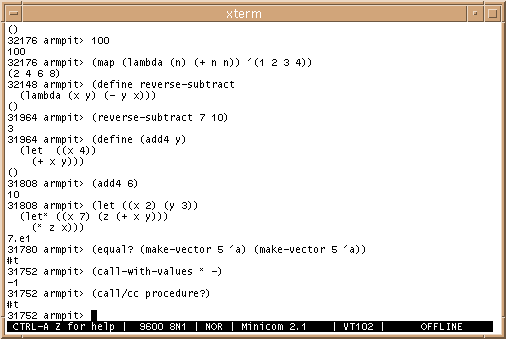
ARMPIT SCHEME is an interpreter for the Scheme language (lexically-scoped dialect of Lisp) that runs on RISC microcontrollers with ARM core. It is based on the description in the Revised^5 Report on the Algorithmic Language Scheme (r5rs), with some extensions (for I/O) and some omissions (to fit within MCU memory). It is further designed to support multitasking and multiprocessing. Armpit Scheme is expected to be well suited to educational settings, including student projects in courses on control and instrumentation, or capstone design courses where microcontrollers are needed. It is meant to enrich the spectrum of interpreted languages available for MCUs (eg. BASIC and FORTH) and can be an alternative to MCU-based bytecode interpreters (eg. for Scheme or Java) and to compiled languages (eg. C).
The name "Armpit" was selected for this project because it includes "ARM" (as in ARM core MCU) and "pit" (as in kernel, noyau, nucleus, the core of an Operating System (OS)). Armpit Scheme, once loaded, governs the operation of the MCU, and is "Scheme to the metal" in the sense of running without any other OS. It may be thought of as turning the MCU into a rudimentary Scheme machine. The screenshot below shows the system running on a NewMicros Tiny2106 board. Minicom is used to communicate with the board which reads, evaluates and prints the result of the entered expressions. The number in front of the "armpit>" prompt indicates the number of bytes of heap space that remain available.

The latest development snapshot of Armpit Scheme is 00.0250 and the current stable version is 00.0160. Both are distributed under the MIT License and are beta releases with both known bugs and unknown bugs. The source code, and pre-assembled (ready-to-upload) Intel Hex and binary image files, can be downloaded from the armpit project summary page or the download site at SourceForge. Alternatively, you can view and download the source code from your web browser. The system is documented in several web pages:
It is designed to run on the following boards (as of latest release):
| USB | ||||||||
| BOARD | MANUFACTURER | MCU | CORE | MHZ | RAM | FLASH | DEVICE | LCD (*) |
| LPC-H2103 | Olimex | LPC2103 | ARM7TDMI | 60 | 8 KB | 32 KB | - | - |
| Tiny2106 | Newmicros | LPC2106 | ARM7TDMI | 60 | 64 KB | 128 KB | - | - |
| Tiny2131 | Newmicros | LPC2131 | ARM7TDMI | 60 | 8 KB | 32 KB | - | - |
| Tiny2138 | Newmicros | LPC2138 | ARM7TDMI | 60 | 32 KB | 512 KB | - | - |
| Logomatic V1.0 | SparkFun | LPC2138 | ARM7TDMI | 60 | 32 KB | 512 KB | - | - |
| Logomatic V2.0 | SparkFun | LPC2148 | ARM7TDMI | 60 | 32 KB | 512 KB | Native | - |
| LPC-H2148 | Olimex | LPC2148 | ARM7TDMI | 60 | 32 KB | 512 KB | Native | - |
| LCDDemo-LPC2158 | Future Designs | LPC2158 | ARM7TDMI | 60 | 32 KB | 512 KB | Native | Text |
| SAM7-H256 | Olimex | AT91SAM7 | ARM7TDMI | 48 | 64 KB | 256 KB | Native | - |
| STR-H711 | Olimex | STR711 | ARM7TDMI | 48 | 64 KB | 256 KB | Native | - |
| LPC-H2214 | Olimex | LPC2214 | ARM7TDMI | 60 | 1 MB | 1 MB | FTDI | - |
| LPC-H2294 | Olimex | LPC2294 | ARM7TDMI | 60 | 1 MB | 4 MB | FTDI | - |
| LPC2478-STK | Olimex | LPC2478 | ARM7TDMI | 72 | 64 MB | 512 KB | Native | Color |
| LPC-H2888 | Olimex | LPC2888 | ARM7TDMI | 48/60 | 32 MB | 2 MB | Native | - |
| CS-E9302 | Olimex | EP9302 | ARM920T | 166 | 32 MB | 16 MB | - | - |
| Hammer | TinCan Tools | S3C2410 | ARM920T | 200 | 32 MB | 16 MB | Native | - |
| STR91X-M | Insem/Lodin | STR911FAW44X6 | ARM966E | 96 | 96 KB | 512 KB | Native | - |
| LPC-P1343 | Olimex | LPC1343 | Cortex-M3 | 72 | 8 KB | 32 KB | Native | - |
| Blueboard 1768H | NGX Electronics | LPC1768 | Cortex-M3 | 96 | 32 KB(*) | 512 KB | Native | - |
| STM32-H103 | Olimex | STM32F103RBT6 | Cortex-M3 | 72 | 20 KB | 128 KB | Native | - |
| STM32-LCD | Olimex | STM32F103ZET6 | Cortex-M3 | 72 | 64 KB | 512 KB | Native | Color |
| STM32 Core Module | InSem/Lodin | STM32F103ZET6 | Cortex-M3 | 72 | 64 KB | 512 KB | Native | - |
| IDM-L35-RDK | TI | LM3S1958 | Cortex-M3 | 50 | 64 KB | 256 KB | (cable) | Color |
| LM3S1968 Eval | TI | LM3S1968 | Cortex-M3 | 50 | 64 KB | 256 KB | FTDI | OLED |
| LM3S6965 Eval | TI | LM3S6965 | Cortex-M3 | 50 | 64 KB | 256 KB | FTDI | OLED |
| BeagleBoard (B7) | TI | OMAP3530 | Cortex-A8 | 600 | 128 MB | 0 MB(*) | Native | - |
| Overo Tide | Gumstix | OMAP3530 | Cortex-A8 | 720 | 512 MB | 0 MB | Native | - |
(*) On-board LCDs / OLEDs are programmed from within user or library space (not in the core). The BeagleBoard onboard flash is not used in the Live-SD version (00.0250). The Blueboard 1768 has 64KB of RAM but it is not contiguous, hence only 32KB is used.
External links of potential interest include: